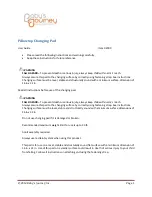
•
Pay attention to the operating
instructions and keep them close to the
battery.
Work on batteries should be carried out
by skilled personnel only!
•
Use protective glasses and clothes when
working on batteries. Pay attention to
the accident prevention rules as well as
EN 50272-3 and EN 501110-1.
•
No smoking! Do not expose batteries to
naked flames, glowing embers or sparks,
as it may cause the battery to explode.
•
Acid splashes into the eyes or on the
skin must be washed with plenty of
water. In case of accident after abundant
flushing consult a doctor immediately!
Clothing contaminated by acid should be
washed in water.
•
Risk of explosion and fire, avoid short
circuits! Caution: metal parts of the
battery are always live. Do not place
tools or other metal objects on the
battery!
Do not remove the plugs.
•
Electrolyte is highly corrosive.
In the normal operation of this battery
contact with acid isn’t possible. If the cell
containers are damaged, the immobili-
sed electrolyte (gelled sulphuric acid) is
corrosive like liquid electrolyte.
•
Batteries and cells are heavy.
Ensure secure installation!
Use only suitable handling equipment.
Lifting hooks must not damage the cells,
connectors or cables.
•
Dangerous electrical voltage!
•
Pay attention to the hazards that can be
caused by batteries.
Fiamm energy dry batteries are valve-regulated, maintenance free batteries. Unlike conventional batteries with liquid
electrolyte they have immobilised electrolyte (gelled sulphuric acid). Instead of a vent plug, a valve is used to regulate the
internal gas pressure, preventing the ingress of oxygen from the air and allowing the escape of excess charging gasses.
When operating valve-regulated lead-acid batteries the same safety requirements as for vented cells apply, to protect against
hazards from electric current, from explosion of electrolytic gas and – with some limitations – from the corrosive electrolyte.
Fiamm energy dry battery valves should never be removed. These batteries do not require topping-up with distilled or
demineralized water.
Instructions for use Fiamm energy dry
Gas recombination traction batteries with positive tubular plates type PzV
Ignoring the operating instructions, repair with non-original parts, disconnection of the Fiamm energycom will render the
warranty void. All the failures, malfunctions or defaults of the battery, the charger or any other accessories, must be
notified to our After Sales Service.
ENGLISH
Rating Data
1. Nominal capacity C
5
: See type plate
2. Nominal voltage
: 2.0 V x No of cells
3. Discharge current
: C
5
/5h
4. Nominal S.G. of electrolyte* Type PzV
: 1.29 kg/l
5. Rated temperature
: 30°C
*Will be reached within the first 10 cycles
1. Commissioning
The Fiamm energy dry battery is equipped with a Fiamm
energycom, electronic device, installed on battery
connectors. The presence of this feature is mandatory on
each Fiamm energy dry battery. The battery should be
inspected to ensure it is in perfect physical condition. Use
special coding systems for maintenance free batteries for
the charging plug- and- socket devices to prevent accidental
connection to a wrong type of charger. The battery end
cables must have a good contact to terminals, check that the
polarity is correct. Otherwise battery, vehicle or charger
could be damaged. The specific torque loading for the bolts
of the charger cables and connectors are:
Steel
M10 connector
25 ± 2 Nm
Never directly connect an electrical appliance (for example:
warning beacon) to some cells of the battery. This could
lead to an imbalance of the cells during the recharge, i.e.
a loss of capacity, the risk of insufficient discharge time,
damage to the cells and this may EFFECT THE WARRANTY
OF THE BATTERY.
Charge before use.
2. Operation
EN 50272-3 “Safety requirements for secondary batteries
and battery installations Part 3: Traction batteries” is the
standard which applies to the operation traction batteries
in industrial trucks.
2.1. Discharge
Ventilation openings must not be sealed or covered.
Electrical connections (e.g. plugs) must only be connected
or disconnected in the open circuit condition. To achieve
the optimum life for the battery, operating discharges of
more than 80 % of the rated capacity must be avoided
(deep discharge). They reduce the battery service life.
To measure the state of discharge use only the battery




















